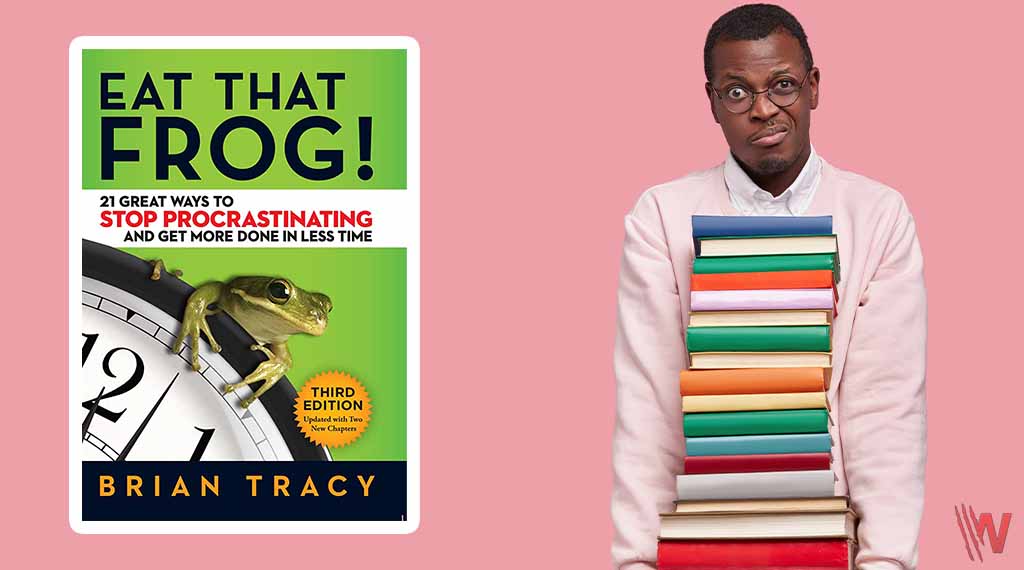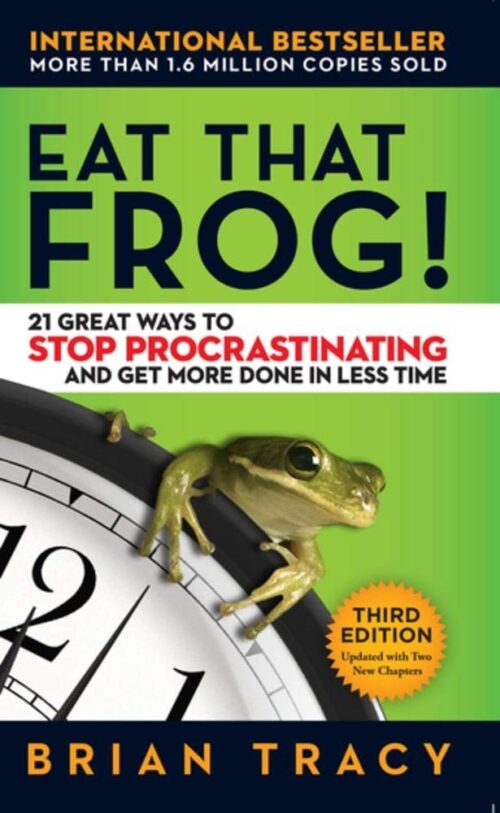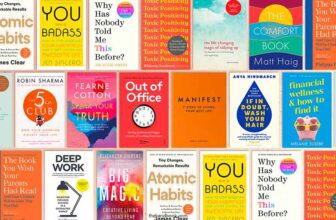Those looking for a pragmatic, yet punchy guide to setting important goals, realizing what is most important, and getting things accomplished expediently, would enjoy self-development and productivity guru Brian Tracy’s 2017 book Eat That Frog.
Eat That Frog Review
Brian Tracy’s writing is accessible, pragmatic, and motivational. His messaging is consistent and intuitive, and his advice is deeply rooted in the “How” and “What” aspects of achieving productivity goals. Needless to say, I’m a big fan of his work.
I read his book Goals! more than a decade ago, and I don’t believe his wording or messaging has changed much during that time. The thing is, it doesn’t need to. The formulas for professional and personal productivity remain steadfast, practical, effective, and timelessly empowering, much like the success principles found in Stop Working Harder.

Having said that, I cannot claim much fanfare in terms of his presentation. Many points are redundantly stated, often adhering to a sing theme with the occasional sprinkling of new details. In that sense 21 Great Ways feels less practical than catchy. So for my review, I have reconstructed the content into a more comprehensive 6-point plan.
That is to take nothing away from Tracy’s original work which presents a motivational theme of planning, prioritizing, and committing to action. Following his advice was instrumental in my productivity and success, when I needed it most about a decade ago. I’ll put it this way: Read this summary of Eat The Frog and if you enjoy it, read the book itself. If you enjoy that, then give the more beefy Goals! a shot. I assure you, his advice will change the way you work, and potentially your life at the same time.
Eat That Frog
Eat That Frog Summary
The key to the achievement of optimal productivity is to reclaim control of your time. Let’s face it: there will never be a lack of things to do, and when you feel like you lack time, it’s likely because your priorities aren’t in order. In order to conquer time, you need to manage it properly.
When you can control your time, you can lend attention to what is most important, which is your relationships. After all, they are what ultimately define your happiness and satisfaction. By managing time, these relationships can be improved. The attributes you need from your time differ based on the arena they are exercised in. At work, the biggest time factor is quality, while in your home and personal life, it is the quantity of time.
Brian Tracy’s suggestion is quite simple: work more often on those things that matter the most to you. His advice breaks down into 6 basic steps:
- Figuring out your goals
- Planning those goals
- Planning the time to spend on achieving those goals
- Setting up for success
- Focus exclusively on the most important tasks
- Once a process is put in place, repeat it regularly
Now, let’s dive deeper into every one of those aspects.
Step 1: Establishing Your Goals
The first step in establishing goals is recognizing what they are. You can start by visualizing each facet of your life 5, 10, or 15 years ahead. This applies to your professional, interpersonal, self-health baked, financial, social, and business aspects of your life.
Next, take 30 seconds to write the top 3 goals in each of those areas. Don’t worry, you can accomplish this in 30 seconds as well as you can in several hours. List each of the goals as if you have already accomplished them. You should write them out on a piece of paper in the first person, with a positive voice, and in the present tense. Then, check off the one goal in every area that would have the most profound impact on your life.
Professional Development Tips
- List 5 to 7 result areas where the responsibility is entirely yours. You are free to do this on your own, or syndicate with your subordinates, management, or coworkers.
- Give yourself a score (1 through 10) in each of those areas
- Focus on the skill with the lowest score to work on for your professional development, as this is the main reason for procrastination. Your goal is to work it up to the scores of your higher-ranked skills.
So for instance, in the arena of sales, you may need to focus on identifying clients’ needs, prospecting, building trust with customers, persuasive presentations, addressing concerns, closing the deal, or achieving referrals/resales.
Step 2: Planning Your Goals
Many people conflate effectiveness and efficiency. To draw the distinction, the former is doing the right thing, and the latter is correctly doing what you are doing. Therefore, this is an action-based topic. For this step, you will want to list what you need to achieve your most pertinent goals. This includes:
- Subsequent actions
- Hurdles to overcome
- Shortcomings
- What you are capable of
- Resources of help
- Others who are contributing
The next part is turning the questions on yourself. Ask yourself why a particular goal isn’t complete already. What is the end goal? Ask yourself how you would get to it. You will also want to utilize Pareto’s 80/20 principle which separates the 20% of tasks that are contributing to 80% of the results, and which 20% of hurdles need to be overcome to maximize at least 80% of the progress.
Next, you will want to consider prioritization with something called the ABCDE method.
- A (Must Do) – which goals carry the heaviest penalty if not completed. These are the tasks that should always get priority on your list.
- B (Should Do) – Some things are not critical, but they should be done, as not doing them carries some level of consequence.
- C (Nice To Do) – These are things that would be great if you could accomplish them, but there is no real consequence to not doing so.
- D (Delegate) – These are things that others can handle on your behalf.
- E (Eliminate) – These are things that aren’t important and are not worth the time.
The next part is to sort the revamped list by logical sequence and priority. Also, the list’s members need to have deadlines set. First, there is the main deadline, and secondary deadlines should be added should they be necessary. Setting deadlines is actually better if they are more aggressive and urgent. These trigger eustress, diffusing Parkinson’s law. When communicating your plan to others, add 20% to planning time because of unexpected distractions, side-bars, deviations, and delays.
In business terms, you would want to write each activity done every week or month and identify those that bring in the highest value. Follow suit with the ones that drive second, third, and so on in values. The list is not prioritized in order of importance. A concerted effort should be made to delegate, brief, or eliminate all other things. Make sure this plan is syndicated with your superiors, workplace counterparts, and employees.
Step 3: Plan Your Time
With priority lists in hand, it’s time to consider the time that will be devoted to each thing on the list. First, write everything down and make sure your list is complete before acting on it. Distribute the items of your list to monthly, weekly, and daily lists prior to each of those periods starting. These lists should be prioritized with the 80/20 principle and the ABCDE technique as before.
Step 4: Setting Up For Success
Now that you know what the most important tasks are to work on, it’s time to give yourself the time, space, energy, and capability to work on the most vital once. Tracy recommends eliminating anything that doesn’t pass the “Zero-Based Thinking” done.
Let’s address time first. You need to carve out large blocks of time on your calendar to engage in uninterrupted progress. If you have the ability to work from home, do so. Also, make an effort to wake up earlier to begin your work.
Clear your docket before engaging in your work. That means clearing out any tasks that are not related to your pertinent work and gathering everything you need for your current tasks that is within your physical reach. Your workspace is an area that should be conducive to productivity. That means it should be clear, appealing, organized, and comfortable to work in (this is especially true for your seat which you will be working from.
Next is the elimination of distractions. While you are working, you should be able to focus specifically on your work. Every minute of work you waste is one you don’t get to spend with family or friends, or attending to more pivotal tasks.
One of our biggest distractors is the seemingly endless flow of emails. Therefore, a pivotal factor is to either eliminate or delegate 80% of our email. You can prepare canned text responses to questions that are asked frequently, have someone help monitor and triage your messages, and set blocks of time aside specifically dedicated to responding to emails.
The other big distraction is electronics. While being disconnected from them entirely is not an option, we can take it in steps. Disconnect yourself from them for one hour every AM and PM, and then choose one full day per week, and disconnect for the entire day.
Another aspect to keep in mind is that no one is good at everything at first. Everyone has to learn and go through a growing phase before they improve. Learning can happen by simply replicating a process or following the examples or templates already laid out for you. But the way to learn is to expand your knowledge. Try reading for an hour a day material about your field. If you travel, use the time to listen to audiobooks on relevant subjects. If seminars are offered, attend as many as you can.
We often procrastinate or are inefficient at work due to a lack of energy. This seems obvious, but in a busy world, it is taken for granted way too many times. The first key is to eat healthily. Think of yourself as a professional athlete. Have a breakfast high in protein, and low in carbs and fats.
For salad eat a salad with some type of white meat like fish and chicken. Limit intake of salt, sugar, and white flour, and try to clamp down on candy, soda, pastries, and desserts. Also, try to exercise at least 200 minutes per week (about a half hour per day). Even more importantly, try to get enough rest. If you work an 8+ hour day, you need your sleep. Try to get to bed by 10 PM and have at least one day during the week for relaxation. Even more importantly, don’t deprive yourself of regular vacations.
Finally, be optimistic. If something seems negative, you may think of it differently from another perspective. Every situation has some degree of good in it, so look for that. If you have a setback, try to collect the valuable lessons you learned from it. Engage in solution orientation, (finding solutions to every problem you encounter) and goal orientation (look forward instead of retrospectively). Face each situation for what it is, refusing to condemn others (or yourself), complain, or criticize.
Step 5: Hone In On Only The Most Vital Tasks
Your most important tasks are your “frogs” so as the book title says, eat them. Make sure that the vital tasks are done ahead of everything else, and focus only on one task. You can only really concentrate on one thing at a time, so don’t attempt to multitask. Doing so may seem great on its face, but only at the cost of energy and momentum. Focus only on the single task you are working on.
Procrastination is the wall you need to overcome to gain momentum. That wall only gets harder to scale if you lack planning (establishing small steps to reach goals), skill (honing your capabilities), and willpower. You need to focus on just one item on your list, even if it is for just 10 minutes. Discipline yourself and you will benefit immensely in terms of productivity.
Most importantly, do not worry about failing. Failure isn’t really a thing, it’s just feedback that you can use to learn, test, experiment, game, and have fun with, all in an effort to better yourself.
Step 6: Repetition
Now that you have the process for success established, it is time to turn it into a habit. Make sure you review the activities that guide you to success regularly. Always evaluate if you are working on the most important thing at the moment. Develop a fast tempo and a sense of urgency. And of course, always remember to work during your designated work times.
It is never a bad decision to optimize your methods. That means you should always be asking yourself how you can maximize your level of efficacy. Consider where you are starting, stopping, and what you can do less of, or more of, to achieve more productivity.
Ultimately, your mindset should be that the time you spend completing work effectively and efficiently means more time spent with your loved ones.
Additional Reading
If you enjoyed the summary of Eat That Frog! or the book itself you might want to consider reading a few other books that will help you expand the methodology of your productivity.
- Goals! by Brian Tracy
- This covers the content of Eat That Frog! but in an expanded manner and more than double the pages. This book is a superb recommendation to help especially to those early in their careers, yielding all types of practical, solid advice that most people only wish they had received as part of their formal education.
- Getting Things Done by David Allen
- A timeless example of efficacy and efficiency. Since I can remember, I have used a variant of David Allen’s approach. It helped me become the sort of person people trust to never drop the ball from from becoming a wild, disorganized mess. This book is for you if you’ve ever wished you could do four times as much while still feeling accomplished and content when you get home.
- The Four Hour Work Week by Tim Ferriss
- This is more than a book. It is a glorified manual on automation and simplification. Brian has the propensity to offer more than he takes away. That gap will be filled by Tim’s advice on automating the time-consuming, trivial aspects of life.
- Think And Grow Rich by Napoleon Hill
- This work is an excellent and essential dose of philosophy. The definition of “Rich” in this book goes well beyond just material wealth. It is an excellent balance of “Why” and “What” to Brian’s powerful “What” and “How.”
- Deep Work by Cal Newport
- Manifesting long periods of uninterrupted work is one of Brian’s finest sections in terms of goals and advice. If you feel lost in the shallows, Newport’s book is a terrifically compelling read that should help anyone right their ship of productivity.
Eat That Frog: Conclusion
Eat That Frog” by Brian Tracy is a book that offers practical advice on how to overcome procrastination and increase productivity. The book’s central metaphor of “eating the frog” refers to tackling the most challenging and important tasks first thing in the morning, rather than delaying or avoiding them.
The key takeaways from the book include the importance of setting clear goals, prioritizing tasks based on their importance, breaking tasks down into smaller steps, using time blocking to manage one’s schedule, and avoiding distractions and interruptions. By adopting these strategies, anyone can overcome procrastination, increase their productivity, and achieve their goals with greater ease and efficiency.
Tai Lopez’s real estate books may have provided valuable insights into the world of investing, but what about productivity? Our next article offers a summary of Brian Tracy’s “Eat That Frog,” a productivity book that teaches readers how to tackle their most important tasks first. Don’t miss out on this valuable tool for maximizing your productivity. Read our article now and take control of your time!
Frequently asked questions:
how old is Brian Tracy?
Brian Tracy is an author, motivational speaker, and success coach born on January 5, 1944, which makes him currently 79 years old.
who is Brian Tracy?
Brian Tracy is a renowned Canadian-American motivational speaker, author, and success expert. He has written and co-authored over 70 books, including “Eat That Frog!” and “The Psychology of Selling,” and has delivered seminars and speeches to millions of people worldwide. Tracy’s teachings focus on the principles of personal and business success, time management, leadership, and productivity.








